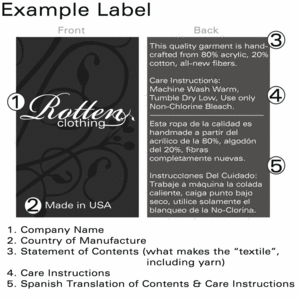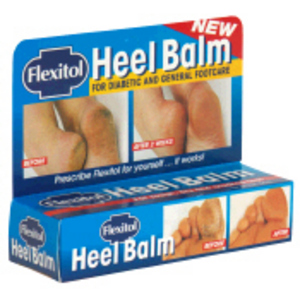We’re all aware of the scratchy labels that are affixed to every piece of clothing we wear (until we get irritated with the scratching and cut them out), hanging off our pillows and linens, and even sewn into the seams of our children’s stuffed toys. Most of us are also aware that those labels are stuck there because US law requires them to be. Who isn’t familiar with the “Remove Under Penalty” tags?
What most crafters don’t know is that those same laws apply to every textile and fiber item they sell.
If you sell clothing, toys, linens, or anything else that is crafted from fabric or yarn (in all its forms, including hemp), you’re responsible for knowing the label laws that govern what you sell. Even if you decide to sell one shirt on eBay that you crafted, you have to include specific information on labels … seriously.
This guide will help you understand what label laws apply to the textile and fiber crafts you create and keep you from landing in hot water. These laws apply to anyone who sells their crafts, so if you’re just gift-giving and not selling, you’ll be fine without labelling. The rest of us need to read on.
The Label: Basic Contents Required
Labeling laws apply to both large-scale manufacturers as well as individual crafters or indie designers. When you’re selling textile and fiber items, you’re required by the government to follow the labeling laws. In the US, the laws are pretty cut and dry. Other countries have similar laws, but what we’re discussing here are specific to the United States. If you live outside the US and are considering selling your work, you’ll want to look into the laws for your country.
Within the US, every textile and fiber item that you sell is required by Federal Law to include labels with at least the following information:
1. Statement of Contents: The content label (or content section on a single label) must include exactly what kind of material the item you’re selling is made from. If you’re using yarn, you’ll want to reference the yarn label – this will give you the contents and percentages to use. Most fabric sold by the bolt does the same thing, but you’ll want to take note of the contents while you’re still at the store so that you have the information ready. In addition to the kind of material used, you must state whether it is all-new or recycled material.
2. Care Instructions: Anyone who has ever done laundry (and cared that their clothes turned out right) is aware of what the Care Instructions look like on a clothing label. You will need to include how to wash, dry, and iron the item. Again, most yarn labels and fabric bolt ends contain this information – all you need to do is include it in your own labels.
3. Country of Manufacture: This is pretty self-explanatory; if you live in the USA, you’ll just state that the item was made in the USA … unless more than 50% of your yarn or fabric was imported. Then you’ll need to state something like “Made in USA, Materials in CountryB”.
4. Company Name: Federal law requires that any clothing (anything that is worn on the body) must also include a label that tells the name of the company that created the item. Individual crafters who don’t have a business name can use use their own name, but it’s got to be there one way or the other.
Label Layout
For the large manufacturer, it’s perfectly reasonable to pay for hundreds of different labels that can be sewn into different spots for each and every need. There’s a single label for care, another for the company (or brand) name, another for the “Made in” tag, etc.
For the rest of us, it just isn’t economical to have to have all these labels printed. Luckily, it’s also not necessary.
Legally speaking, your items for sell have to include at least one label that contains all the information required by law. A single label will work just fine – reference the illustration included with this article for an example. By designing a single label to be used as either a hang tag or embroidered and sewn into the garment (which follows legal guidelines more closely, but is more expensive as well), you can save a ton of money.
Important Label Resources
To go into more detail on label requirements, it would be necessary to know exactly what kind of product(s) you’re selling, what they’re made from, and where you obtained the materials from. That’s just not very reasonable for an article, so I’m going the next-best option and listing resources that can help you out if you need more specific information than the basic standards covered here.
Translations – It’s always a good idea to include a translation of your content and care instructions if you live in an area that has a large number of people who speak a different language than English. One of the most reliable – and free – resources online for quick translations to a number of languages is Babelfish.
Rules & Regulations – The Federal Trade Commission (in typical government overkill manner) has laid out all of the specific rules and regulations “Under the Textile Fiber Products Identification Act” on this page. In particular, you’ll want to check out the files for generic names and definitions of manufactured fibers, sale of remnants (recycled materials), products containing unknown fibers, and the required label and method of affixing. There are a couple dozen files on this page, each of which address a specific issue that may or may not apply to your product(s). If they do, they’re definitely worth a read.
Woven Labels – There are dozens of websites out there for ordering woven labels that include your company name and country of manufacture in a variety of designs. Why not support another handcrafter, though? There are several sellers on Etsy that create fantastic custom labels, including Jennifer’s Jewels, Red Rebel Labels, and Bitsy Creations.
Stock Content & Care Labels – If you have a pretty standard content set in your materials (100% of anything, 50/50, etc.), you can grab stock labels from Sterling Name Tape for under $10 for sets of 100. They also offer Made in USA labels and size labels – very nice stuff.
And remember – there’s nothing stopping you from creating your own labels. All that you need is some printable fabric and you’re off and running.




